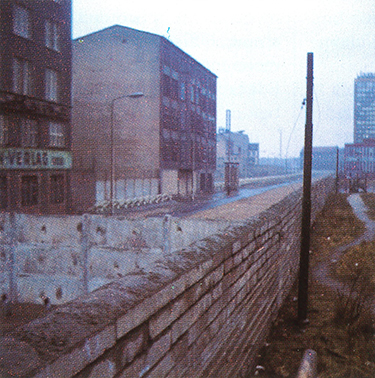Fall of the Berlin Wall is cause for celebration

The Berlin Wall, 1974. Photo by Tom Griffin.
On a chilly, rainy day in 1974, I came out of the subway near Checkpoint Charlie and had my first glimpse of the Berlin Wall. This was years before West Berlin’s street youth painted their side of the wall with colorful graffiti. Instead, the cinder block gray matched the sky, and at first both engendered feelings of depression.
But then, as I climbed the wooden stairs to a platform that allowed a peek over the wall, depression turned to anger. How could someone allow this to happen, I asked myself. This great city, divided in half, with automatic machine guns, menacing German shepherds and, in the guard towers every 300 meters, the hated Stasi—the state security police—determined to keep it that way.
When I heard the news last November that the Berlin Wall had opened, I was filled with joy, as most of us were. Having seen the wall, it seemed indestructible in my mind’s eye. I never expected to watch the dancing crowds atop der Mauer in my lifetime. And the experts were dumbfounded as well. International Studies Professor Herbert Ellison, who is making a documentary on Communism in crisis for the BBC and U.S. public television, was just as surprised. “I don’t think anyone could have expected how rapidly it would come apart,” he told me when I interviewed him about his TV series and the turmoil in the East Bloc.
Twenty years before these events, another revolution was taking place, this time on American college campuses. The Vietnam War intensified as President Nixon ordered American troops into Cambodia. The reaction was fierce even before the deaths of four students at Kent State. After that tragedy, peaceful protest turned into a firestorm of violence. Yet at the University of Washington the students, police and administration were spared the worst. What made the UW different from Berkeley, Kent State, Columbia, Maryland, Wisconsin and the rest? Perhaps because at the UW there wasn’t a wall between the students and the “other side,” the faculty and administrators. Our cover story looks at the events of May 1970 from the perspective of these UW officials.
This issue also includes articles on back pain, recruiting graduate students and a profile of retiring Alumni Relations Director Tracy King. We also feature UW news, alumni activities and two pages of letters, some complimentary, others critical of our new name and format. Letters are one way to break down the wall between a magazine and its readers. If you would like to do your part to widen the opening, our address is on page three.